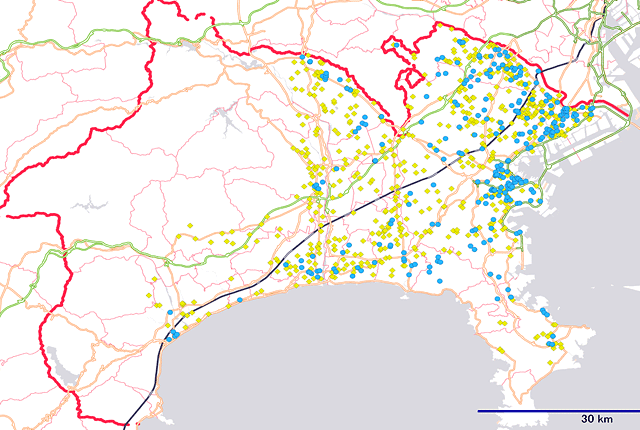Development of rental storage and container storage in Kanagawa
 (Blue = rental storage, Yellow = container storage)
(Blue = rental storage, Yellow = container storage)
In Kanagawa Prefecture, as of July 2013, approximately 1,100 rental storage and container storage business units have been developed.
The above mapping data shows that rental storage business units (blue dots) are relatively concentrated in the urban areas of Kawasaki-shi and Yokohama-shi. We can see that container storage business units (yellow dots), on the other hand, are scattered fairly evenly throughout the prefecture except in mountainous areas.
In the suburbs of Yokohama-shi (where there are relatively many residential areas and detached houses), storage business units are relatively few and not concentrated. Business units stand side by side along national highways and other major roads.
For example, alongside the coastal National Route 134 are rental storage and container storage business units where many people seem to store their surfboards and other marine sport equipment. This is an illustration of how urban areas and suburban areas each have their own different storage needs.
[Kanagawa Prefecture municipal districts – Ranking for storage business units]
| Kanagawa Prefectu |
Population |
Rental storage business units |
Container storage business units |
Total business units |
| Fujisawa-shi |
419,260 |
16 |
67 |
83 |
| Tsurumi-ku |
281,461 |
22 |
36 |
58 |
| Hiratsuka-shi |
257,333 |
11 |
42 |
53 |
| Takatsu-ku |
224,379 |
12 |
36 |
48 |
| Kawasaki-ku |
219,21 |
21 |
25 |
46 |
| Atsugi-shi |
225,041 |
7 |
39 |
46 |
| Tsuzuki-ku |
210,258 |
10 |
34 |
44 |
| Kohoku-ku |
340,798 |
12 |
27 |
39 |
| Chigasaki-shi |
237,607 |
7 |
32 |
39 |
| Yokosuka-shi |
408,112 |
8 |
27 |
35 |
(Yellow highlighted districts are in Yokohama-shi, orange in Kawasaki-shi)
Looking at the ranking of administrative districts within Kanagawa Prefecture for the number of storage business units, among the most populated districts (1st: Fujisawa-shi, 2nd: Yokosuka-shi, 3rd: Kohoku-ku, Yokohama-shi, 4th: Aoba-ku, Yokohama-shi, 5th: Tsurumi-ku, Yokohama-shi), fourth most populated Aoba-ku has only 18 storage locations. Second and third most populated Yokosuka-shi and Kohoku-ku, Yokohama-shi may have the potential for more than 50 locations, like the highest three ranking districts.
In such areas, however, the populations of administrative districts have been rising sharply in recent years. This is particularly true of areas where children are born and brought up. Examples are areas that have recently had high-profile problems with waiting lists for kindergartens or schools. Such areas have large potential because demand for storage will gradually increase in future as the children grow up and require more storage.
There are more than 20 rental storage business units each in central Kawasaki-shi (Kawasaki-ku) and central Yokohama-shi (Chuo-ku). Rental storage is also concentrated in districts of Kanagawa Prefecture that have a lot of industry and commerce and a high population, such as Tsurumi-ku, located between Kawasaki and Yokohama, where there are more than 20 business units.
The leading districts for container storage are the suburbs of Fujisawa-shi, Hiratsuka-shi and Atsugi-shi. Fourth placed Tsurumi-ku is also highly ranked for rental storage. Although Kanagawa is not demarcated in any way like Tokyo (by the Yamanote Line or ring road No.7), we can say there tends to be lot of rental storage in the so-called urban areas of Yokohama-shi and Kawasaki-shi, a mixture of rental and container storage in mostly residential areas, and a lot of container storage in urban areas outside Yokohama-shi and Kawasaki-shi.